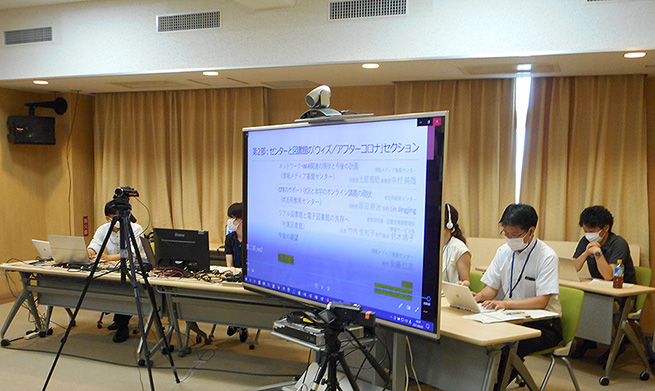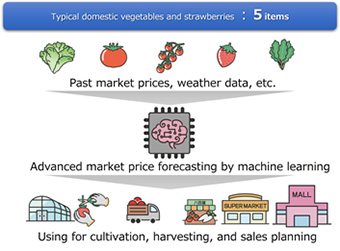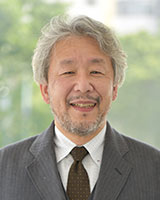
ここからコンテンツです。

DX of Education and Research in Computer Science
Hitoshi Goto

Universities have not been spared the serious impact of the pandemic. In early April 2020, right before the start of the new semester, Toyohashi University of Technology decided to close the school due to concerns about the spread of COVID-19. Preparations were made to implement remote teaching from May 15. The person appointed to lead this effort was Professor Hitoshi Goto of the Information and Media Center, head of the Center for IT-Based Education. We have asked him to reflect on his struggles as a center head during the COVID-19 pandemic and about cutting-edge research in his area of expertise that is computer molecular simulations.
Interview and report by Madoka Tainaka
The Center for IT-Based Education that became a COVID-19 countermeasures office
In April 2020 the Center for IT-Based Education was established as an independent entity, separate from the Information and Media Center, with Professor Goto being appointed as its head. The decision to close down the school came more or less at the same times as his appointment, so the center immediately had to deal with the impact of COVID-19.
Professor Goto looks back on their activities over the last two years, saying "The timing was horrendous. The plan was for the center to prepare and advance online teaching and e-learning as well as the digitization and digital transformation (DX) of education, but we were given no time to draw up a vision as were immediately in firefighting mode as a COVID-19 countermeasures office. Nevertheless, I think one major advantage was that we could speed up the engagement with IT of teachers and students through the pandemic."
We were just fumbling in the dark in the beginning. The first thing Professor Goto did ahead of the one-month preparation for the start of remote teaching was to find people. He invited two teachers with expertise in system development in the information field, as well as quickly recruiting five research assistants (RA) from among the student body. Together with his staff, he quickly completed a new students' handbook for connecting and receiving remote teaching and a teachers' handbook for developing remote teaching materials.
They also provided undergraduate students with an online programming learning tool for beginners called CodeMonkey during the one month the school was closed. Although only half of the undergraduate students actually used the tool, it was popular among those who had never studied programming before.
Another question was what system to use for on-demand teaching.
"In the beginning, we were thinking about expanding and using Moodle, which was used by some professors in the information field. Yet, because of the many functions of Moodle, it also places a heavy burden on the servers and school network, so we deemed that 1,500 lectures would be too much and switched to Google Classroom. The functionality is simpler than Moodle, but I think we avoided a lot of confusion since it can be used intuitively."
Thus, in May 2020, they started with on-demand teaching based on lecture materials to reduce the burden on the network, which allowed them to begin remote teaching without any major problems.
Supporting the teachers and students through detailed responses
At the same time, to respond to the inevitable teething troubles of a brand new initiative, there was a need for detailed followup support.
In addition to lending out laptop computers and Wi-Fi routers to faculty and students who said they did not have their own computer, did not have the necessary performance, did not have a camera, or did not have a network environment, they also worked hard to strengthen the campus network and ensure information security. Moreover, they made sure that no students were excluded from online teaching by identifying those unable to access the course system and Google Classroom and providing individual support.
"In the case of our school, many students live in dormitories and apartments near the university, so we were confident that they could help each other out in their labs, but the same conditions did not apply for new students. To help them with getting used to this new initiative, we carefully created a handbook in the form of an FAQ and kept updating the information as we ran into new issues. So in effect we became like a helpdesk to support students and teachers."

After about one year, they started seeing some issues with remote teaching. On-demand teaching where materials are distributed and you can repeatedly watch lectures when you want was generally liked by students, but opinions were divided when it came to the availability of materials and whether teachers followup in their audio or videos and actively communicate through the chat and other means. Many students also felt a heavier burden as more assignments were issued because of the lack of teaching in real time. At the same time, teachers pretty much had no choice but to issue essays and other assignments since it is difficult to know the situation and responses of students remotely or check how well they understand the content.
Luckily, experiments needed for training courses could be carried out as focused lectures during the summer and afterward when the pandemic situation had somewhat abated.
"My regret is about overseas students. We found a way to make it possible for them to attend lectures online, but many eventually gave up on coming to Japan. It's still difficult for overseas students to come, so this is a point where we want to ask for the government to make improvements, to support our role as a school that promotes global learning."
Education DX through the pandemic
Two-way online teaching using video meeting systems like Google Meet became more common in 2021, while more than half of lectures are conducted in person now that the pandemic has settled a bit. However, Professor Goto strongly believes that we must not stop the flow towards the digitization of education that was accelerated by the pandemic.
"In the future, we want to implement so-called high-flex online teaching, where materials are distributed in advance and classes are recorded as they are provided in person and online at the same time, and then made available on-demand. It's through initiatives like this that we want to speed up education DX, which was the initial aim of the Center for IT-Based Education."
Something that Professor Goto has his eyes on with regard to this is learning record data (logs). He says that he wants to accumulate and analyze learning logs to provide better followup to the respective students.
"We know that students who are forced to drop credits, take a break from school, or drop out stop coming to class an average of six weeks prior. We want to create systems for providing suitable care when finding early signs in learning logs. We are also thinking about how to realize IT-based active learning that boosts student learning."
Furthermore, as the core of the "Mathematical Data Science and AI Education Program" promoted by the government, which has been the mission of the IT Education Center since its inception, the center will be responsible for training data scientists. We plan to apply for the program to be recognized by MEXT at the end of 2021, and we aim to have more than half of students at the university enrolled in the future.
Generating innovative results through research DX
Professor Goto predicts that DX is also likely to accelerate in the world of research, which in his case means the field of computational chemistry. In particular, he thinks that innovative results will come from the merging of AI with observational technologies and computer science.
"When I was at Hokkaido University, I conducted research like elucidating the structure of organic molecules through computations and predicting their properties, working under Professor Eiji Osawa, who is known for predicting the existence of the fullerene molecule in 1970. When he moved to this university in 1990, I followed him to Toyohashi. Since then, for the past 30 years, I have been working on developing molecular simulations and analytical support systems. During this time, I have witnessed the remarkable progress of computational chemistry from its early days to the present.
At present, vaccine development and drug discovery wouldn't be possible without computer science. I think it will be used in all kinds of fields in the future, both in the humanities and the sciences."

He has recently been involved in research on soft crystals, which are organic molecules that change shape when force is added from outside and then change back when that force is removed. This research made the first discovery of organic molecules with a hyperelastic property and the findings were published in an international journal together with top-level researchers in Japan and abroad.
Professor Goto outlines the prospects, saying "Computational chemistry can be applied in various ways. To date, we have been focusing on basic research. I hope that we can conduct applied research that leads to antibody design and vaccine development through structural analysis of viral spike proteins and so forth."
Professor Goto's efforts are likely to expand even further, using computer science as a tool for DX not only in education but also in research.
Reporter's Note
Professor Goto's research is not just computational chemistry but also extends to chemoinformatics utilizing machine learning. Machine learning is used to predict properties from the composition and three-dimensional structure of materials, and these learning machines are highly versatile so that they can be applied in a variety of fields. One of them is predicting the market price of vegetables produced in plant factories.

Professor Goto says, "If you input weather data, production area information, and market prices into the learning machine, it can accurately predict prices. We are already working to commercialize this together with a startup that has distribution channels to supermarkets."
Computer science is an academic discipline indispensable to DX in education and research as well as to society as a whole. It is clear that people like Professor Goto, who can complement their research expertise with their skills in computation and AI, will become ever more essential in the future.
コンピュータサイエンスで教育・研究のDXを
パンデミックは、大学にも深刻な影響をもたらした。豊橋技術科学大学では、新型コロナウイルス感染症の拡大を懸念して、新学期が始まる直前の2020年4月頭に休校を決定。翌5月15日から遠隔授業を実施すべく準備を進めた。その推進役を担ったのが、情報メディ基盤センター所属、IT活用教育センター長の後藤仁志教授である。コロナ禍でのセンター長としての奮闘を振り返るとともに、専門であるコンピュータを駆使した分子シミュレーションなどの先端研究について聞いた。
コロナ対策室と化したIT活用教育センター
情報メディア基盤センターから独立する形でIT活用教育センターが発足し、後藤教授がセンター長に就任したのは2020年4月。就任とほぼ同時に休校が決まり、センターは即座にコロナ対応を迫られることになった。
「最悪のタイミングですよね。本来なら、当センターではオンライン授業やeラーニング、教育のデジタル・トランスフォーメーション(DX)を準備して進めるつもりでしたが、ビジョンを描く間もなく、急遽、コロナ対策室と化してしまったわけですから。ただ、コロナ禍を経て、教員、学生ともにIT化への取り組みを加速できたことは大きなメリットだったと思っています」と、後藤教授は2年に渡る活動を振り返る。
当初はすべてが手探りだった。まず、遠隔授業開始までの1カ月の準備期間を前に後藤教授が手掛けたのが人集めだ。システム構築に詳しい情報系の教員2名に声をかけるとともに、在学生の中から5名のリサーチ・アシスタント(RA)を急募。スタッフとともに、新入生向けの遠隔授業の接続・受講マニュアルと、教員向けの遠隔授業の教材開発のためのマニュアルを急ぎ作成した。
また、学部生に対しては、1か月の休校期間中に、初心者向けのオンラインプログラミング学習「CodeMonkey(コードモンキー)」を提供した。実際に取り組んだのは学部生の半数程度だったが、プログラミングを学んでこなかった学生には好評だったという。
オンデマンド授業にどのシステムを使うのかも課題だった。
「当初は、一部の情報系の教授らが利用していたMoodle(オープンソースのeラーニングプラットフォーム)を拡張して活用するつもりでした。ところがMoodleは機能が充実している分だけサーバーや学内ネットワークに負荷がかかることから、約1500もの講義には耐えられないと判断し、最終的にGoogle Classroomへ切り替えました。Moodleよりシンプルで機能は劣りますが、直感的に使えることから混乱は少なかったと思います」
ネットワークへの負荷を減らすために講義資料をベースにしたオンデマンド授業が中心ではあったが、2020年5月からは大きなトラブルもなく遠隔授業をスタートさせることができた。
きめ細かな対応で教員・学生をフォロー
一方、初めての取り組みゆえに、きめ細かなフォローが欠かせなかったという。
「自分のパソコンがない」「性能が足りない」「カメラがついていない」「ネットワーク環境がない」といった教員や学生のために、ノートPCやWi-Fiルーターなどを貸し出すとともに、学内のネットワークの強化や情報セキュリティの確保にも奔走した。また、履修システムやGoogle Classroomに入れないでいる学生を洗い出し、個別に対応することで、学生全員が確実に授業を受けられるようにした。
「本校の場合、在学生の多くは寮や大学の側のアパートにいて、研究室で互いに助け合える環境にあることから心配はしていませんでした。しかし、新入生はそうはいきません。新しい取り組みに慣れない彼らのために、FAQのようなかたちで、マニュアルを丁寧につくり、問題が出てくるたびに情報を更新しました。つまり我々が、学生や教員のサポート窓口になったわけです」
一年を過ぎる頃には、遠隔授業の課題も見えてきた。講義資料が配布され、好きなときに繰り返し学習できるオンデマンド授業は学生からはおおむね好評だったが、資料の充実度に加えて、教員が音声や動画でフォローし、チャットなどを通じてコミュニケーションを積極的に図ったかどうかで評価が分かれた。リアルタイムでの講義ができない分、多くの授業で課題が出されたことに負担を感じる学生も多かった。もっとも教員からすれば、遠隔では学生の状況や反応が見えにくく、理解度を確認するために、レポートなどの課題を課さざるを得なかったと言える。
幸い、演習を必要とする実験などに関しては、感染状況が比較的落ち着いていた夏以降に集中講義形式で実施することができた。
「悔やまれるのは、海外の留学生です。なんとかオンラインで授業を受講できるようになったものの、その後、渡日をあきらめてしまったケースも多くありました。いまだに留学生の来日は難しく、グローバルな学びを推進する我が校としては、政府にぜひとも改善していただきたいと思っています」
コロナ禍を経て教育DXへ
2021年以降は、ビデオ会議システムのGoogle Meetなどを使った同時双方向のオンライン授業が増え、感染状況が落ち着いた現在では、半数以上の授業が対面に戻っている。ただし、パンデミックによって加速したIT化の流れを止めてはいけないと後藤教授は言う。
「今後は、講義資料を事前に配布したうえで、対面授業とオンラン授業を同時開催して録画し、オンデマンドでも配信する、いわゆるハイフレックス型のオンライン授業を実施していきたい。こうした取り組みを踏まえて、IT活用教育センターの当初の目的である教育DXを加速していきたいと考えています」
そうしたなかで後藤教授が注目するのが、学習履歴データ(ログ)の活用だ。学習ログを蓄積・分析することで、それぞれの学生のフォローに役立てたいという。
「単位を落とし、休学、退学に追い込まれる学生は、平均して6週目くらいから講義に出なくなることがわかっています。学習ログからそうした兆候を見つけて適切にケアしていくしくみをつくりたい。また、学生の学びを伸ばすようITを活用したアクティブラーニングなども実現していけたらと考えています」
さらには、IT活用教育センターの当初からの使命である、国が推進する「数理データサイエンス・AI教育プログラム」の学内の中核として、データサイエンティストの養成も担っていく。本プログラムは2021年度末に、文部科学省の認定制度への申し込みを予定していて、今後は、全学生の半数以上の履修をめざすという。
研究DXで革新的な成果を生み出す
ところで、後藤教授の専門は計算化学だが、今後は研究の世界でもDXが加速していくだろうと語る。とくに、観測技術とコンピュータサイエンス、AIが融合することで、革新的な成果が生まれると見ている。
「北海道大学にいた頃は、1970年にフラーレン分子の存在を予想したことで知られる大澤映二先生のもと、計算で有機分子の構造を明らかにしたり、その物性を予測したりといった研究をしていました。90年に大澤先生が本学に異動されたときに、私も一緒に豊橋に移り、その後、30年以上に渡り、分子シミュレーションや解析支援システムの開発などに取り組んできました。まさに計算化学の黎明期から現在までのめざましい進展を目の当たりにしてきたわけです。いまやワクチン開発や創薬なども、コンピュータサイエンスなしには実現できません。今後は文理を問わず、あらゆる分野で活用されていくことになるでしょう」
最近は、外から力を加えると変形し、力が除かれると元に戻るという有機分子の結晶「ソフトクリスタル」の研究を手がけた。超弾性の性質を持つ有機分子が発見されたのは初めてで、国内外のトップレベルの研究者とともに研究成果を国際ジャーナルに発表した。
「計算化学の応用分野はさまざまです。これまで基礎研究に重きを置いてきましたが、今後は、ウイルスのスパイクタンパク質の構造解析などの研究を通じて、抗体の設計やワクチン開発にまでつながるような応用研究を狙っていきたいですね」と、後藤教授は展望を語る。
コンピュータサイエンスを武器に、教育のDXだけでなく、研究においても後藤教授の取り組みはさらなる広がりを見せることになりそうだ。
(取材・文=田井中 麻都佳)
取材後記
後藤教授の研究は、計算化学だけでなく、機械学習などを活用した情報化学(ケモインフォマティクス)にも広がっている。機械学習を用いて、物質の組成や立体構造から物性を予測しているが、このときに使っている学習器は汎用性が高く、さまざまな分野へ応用可能なのだという。その一つが、植物工場で生産する野菜の市場価格予測だ。
「気象データと産地情報、市場の価格を学習器に入れてやると、精度良く価格を予測できるのです。こちらはすでにスーパーマーケットへの物流のチャネルを持つベンチャーとともに事業化を進めています」と後藤教授。
コンピュータサイエンスは、教育や研究はもちろんのこと、社会全体のDXに不可欠な学問である。後藤教授のように、専門分野とともに計算やAIに通じる人材は、今後ますます必要とされることは間違いない。
Researcher Profile

Hitoshi Goto
Hitoshi Goto received PhD degree in 1993 from Hokkaido University. He started his career at Toyohashi University of Technology as an assistant professor in 1996 and has been worked as a professor since 2020.
His research interests are in computational chemistry and chemoinformatics for organic compounds and materials. Recently, he has been working on research such as price forecasts in the vegetable market and vegetable growth forecasts in plant factories by applying the machine learning methods cultivated in chemoinformatics.
Reporter Profile

Madoka Tainaka is a freelance editor, writer and interpreter. She graduated in Law from Chuo University, Japan. She served as a chief editor of "Nature Interface" magazine, a committee for the promotion of Information and Science Technology at MEXT (Ministry of Education, Culture, Sports, Science and Technology).
ここでコンテンツ終わりです。

